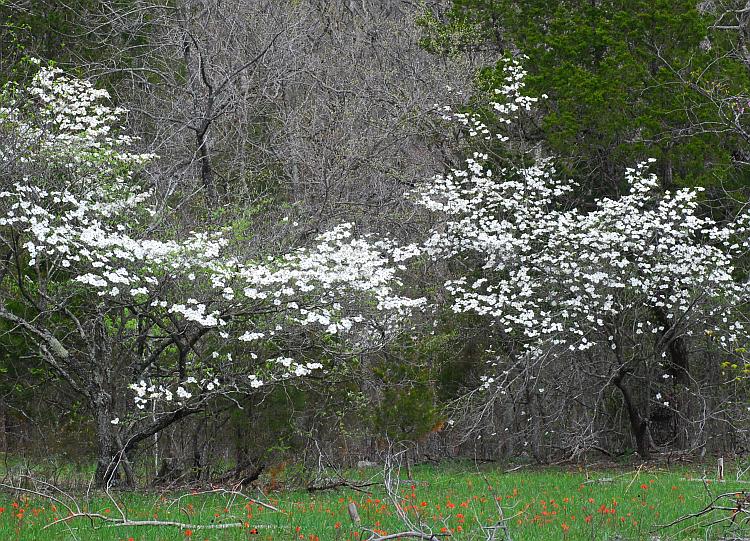Cornus florida L.
Flowering Dogwood

Native
CC = 5
CW = 3
MOC = 71
© SRTurner
Cornus florida L.Flowering Dogwood | |
 |
Native CC = 5 CW = 3 MOC = 71 |
© SRTurner |
|
Family - Cornaceae Habit - Small tree, to 15 m, usually solitary. Stems - Twigs reddish brown to reddish gray or green, moderately to densely appressed-hairy, the pith usually tan. Bark relatively deeply fissured, the ridges becoming divided into a somewhat regular pattern of polygonal to oblong plates, dark gray to brown.
Leaves - Opposite, petiolate, entire, positioned mostly toward the tips of the branches. Petioles 0.3-1.2 cm long, pubescent. Leaf blades 5-12 cm long, 3-8 cm wide, ovate to broadly elliptic or occasionally elliptic-obovate, rounded, angled, or short-tapered at the base, angled or more commonly tapered to a sharply pointed tip, the surfaces sparsely to densely pubescent with mostly appressed, straight, T-shaped hairs when young, the undersurface sometimes also with longer, more or less spreading, V-shaped or Y-shaped hairs along the main veins, sometimes becoming glabrous or nearly so at maturity, the lateral veins (4)5-7 pairs, these relatively evenly spaced. Veins of leaves impressed adaxially, expressed abaxially, arching forward near margins. A silky thread of elastic vasculature is visible when the leaves are gently split crosswise.
Inflorescence - Dense heads subtended by 4 showy petaloid bracts, these 2.5-5.0 cm long, broadly obovate to nearly circular or somewhat heart-shaped, shallowly notched at the tip, white or rarely pink, the flowers sessile or nearly so. Flowers appearing with or just before the leaves. Peduncle to 3.5 cm long, densely pubescent. Flowers ~20 per cluster.
Flowers - Sepals 4, acute, fused below the midpoint, the lobes 0.5-1.0 mm long. Petals 4, yellow-green, glabrous, 3-4 mm long, narrowly oblong-lanceolate, greenish yellow. Stamens 4, exserted, erect, alternating with the petals. Filaments glabrous, whitish-green, 2.0-2.5 mm long. Anthers 1.2 mm long. Style 3-4 mm long, relatively slender, not broadened toward the tip. Ovary inferior, 2-locular. Placentation axile.
Fruits - Drupes 7-14 mm long, ovoid to ellipsoid, red (sometimes turning black with age). Stone strongly longitudinally veined but smooth or shallowly and inconspicuously grooved.
Flowering - April - May. Habitat - Forests, savannas, glade margins, bluffs, ravines, ridges. Origin - Native to the U.S. Lookalikes - None close. At a distance, there is some resemblance to Amelanchier arborea. Other info. - This well-known and striking tree grows wild across much of Missouri, though apparently not in the northwestern third of the state. In fact, Missouri populations are at the northwestern corner of the plant's natural range, which extends southward to Texas and and north and east to the Atlantic coast. It is also widely cultivated. When the tree is flowering it is impossible to mistake, since nothing else in the region looks like it. It is also easily recognized when not flowering, by the patterned bark, and when in fruit by the clusters of red drupes.
Traditionally, the plant was used for many ailments including diarrhea and malaria. The twigs were often chewed to help whiten the teeth and were the forerunner of the modern day toothbrush. It is the official state tree of Missouri. In a good year, the springtime displays can be spectacular, often overlapping those of redbud. The red fruits are an important food source for birds and small mammals. Native Americans prepared red dye from the roots and used the inner bark as a quinine substitute for treatment of malaria. The wood has been used to fashion numerous small objects, such as golf clubs, tool handles, mallets, engraving blocks, etc. Photographs taken at the Noblett Lake Recreational Area, Douglas County, MO., 4-15-01, in Brown Summit, NC, 4-8-02, at Reform Conservation Area, Callaway County, MO., 3-11-04, and in Columbia, MO., 4-21-07 (DETenaglia); also at Valley View Glade Natural Area, Jefferson County, MO, 4-24-2009, 4-5-2011, Shaw Nature Reserve, Franklin County, MO, 9-22-2010, Weldon Spring Conservation Area, St. Charles County, MO, 4-13-2011, Young Conservation Area, Jefferson County, MO, 4-12-2017, and Don Robinson State Park, Jefferson County, MO, 4-26-2019 (SRTurner); also via focus stacking technique (Rick Gray). |